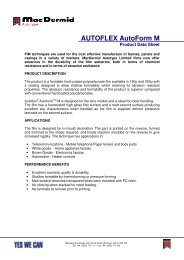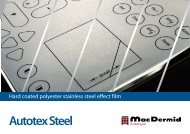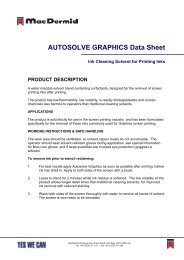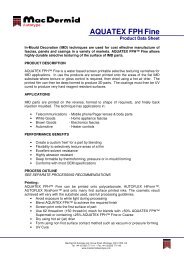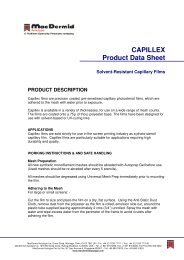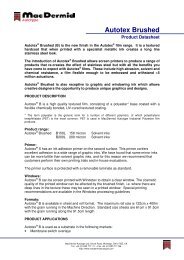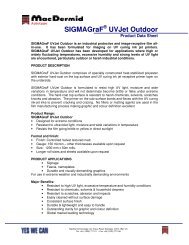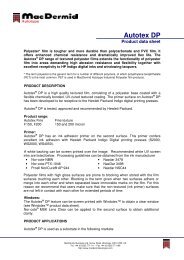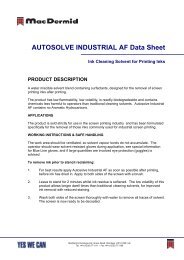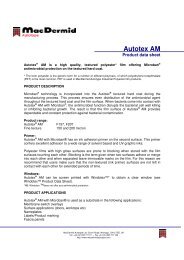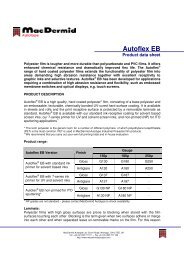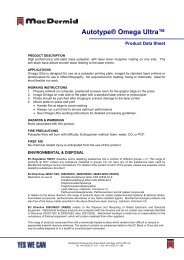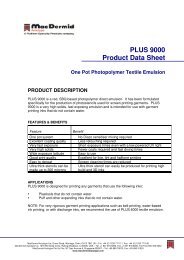Screen E-Book (.PDF) - MacDermid Autotype
Screen E-Book (.PDF) - MacDermid Autotype
Screen E-Book (.PDF) - MacDermid Autotype
- No tags were found...
You also want an ePaper? Increase the reach of your titles
YUMPU automatically turns print PDFs into web optimized ePapers that Google loves.
Glossary136Moiré amplitudeThe amplitude of a sound is how loud itis – you can easily hear a loud (high amplitude)sound and can’t hear a soft (low amplitude)sound. The amplitude of a moiréis a measure of how visible it is – a highamplitude moiré is easily visible.MRNThis is the Moiré Ratio Number, the ratio ofthe frequency of your print (in other words,the halftone ruling) to the moiré frequency.An MRN of 4 or more means that you arelikely to see the moiré.Loupe & MicroscopeMost printers have a hand-held magnifier,commonly called a loupe. If you needgreater magnification you normally haveto use a microscope.ViscosityThis is measure of how easily a liquid flows,with a runny liquid being a low viscosity.It is scientifically measured in Pas (Pascalseconds)or in cP (centiPoise) or Poise.However as a rough guide, “low” viscosity iswater (0.001Pas), “medium” viscosity is honey(3Pas) and “high” viscosity starts at molasses(or treacle depending your linguistictradition) (10Pas) through peanut butter(200Pas) up to window putty (100,000Pas)Non-Newtonian ViscositySimple viscous liquids don’t change theirviscosity when you stir, mix, squeeze or inany other way “shear” them. They are saidto be “Newtonian”. Typical screen printinginks tend to reduce their viscosity whensheared and are said to be Non-Newtonian.Is non-Newtonian behaviour desirable? Ingeneral it’s what you want, but if the non-Newtonian behaviour is time-dependent(i.e. the change in viscosity depends onhow long ago you sheared it) then that’sprobably undesirable.ViscoelasticityA simple liquid is viscous. A simple rubberis elastic. But many liquids have a stretchycomponent to them and many rubbersflow when stretched. This mixture of viscosityand stretchiness is called Viscoelasticityand in general is undesirable for screenprinting. It’s rather difficult to measure viscoelasticity,but most printers are used to amore homely descriptive term: “tackiness”or “stringiness”.Surface TensionWe all know that water tends to formspherical drops, and that by adding a surfactantthis tendency greatly reduces. Theforce which causes the water to bead up iscalled Surface Tension. Surfactants greatlyreduce this force. Pure water has a surfacetension of 72 dynes/cm. Adding typicalsurfactants will bring that down to a leveltypical of simple alcohols, 30-40 dynes/cm.It is hard to get a liquid with a surface tensionbelow 20-dynes/cm. Note that viscositycovers a huge range (the samples quotedabove cover a range of 100,000,000),but surface tension usually varies only bya factor of 2-3.Surface EnergyA drop of water on glass or metal tendsto spread out. The “surface energy” of thesurface tends to overcome the surfacetension of the water. On a typical plastic,



